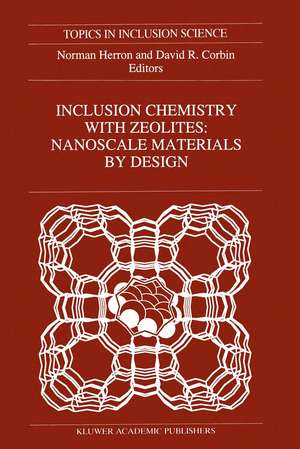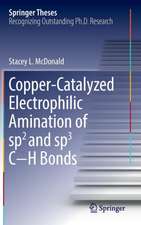Inclusion Chemistry with Zeolites: Nanoscale Materials by Design: Topics in Inclusion Science, cartea 6
Editat de N. Herron, D. R. Corbinen Limba Engleză Paperback – 21 oct 2012
Preț: 391.79 lei
Nou
Puncte Express: 588
Preț estimativ în valută:
74.97€ • 78.27$ • 62.05£
74.97€ • 78.27$ • 62.05£
Carte tipărită la comandă
Livrare economică 04-18 aprilie
Preluare comenzi: 021 569.72.76
Specificații
ISBN-13: 9789401040570
ISBN-10: 9401040575
Pagini: 360
Ilustrații: XV, 340 p.
Dimensiuni: 160 x 240 x 19 mm
Greutate: 0.5 kg
Ediția:Softcover reprint of the original 1st ed. 1995
Editura: SPRINGER NETHERLANDS
Colecția Springer
Seria Topics in Inclusion Science
Locul publicării:Dordrecht, Netherlands
ISBN-10: 9401040575
Pagini: 360
Ilustrații: XV, 340 p.
Dimensiuni: 160 x 240 x 19 mm
Greutate: 0.5 kg
Ediția:Softcover reprint of the original 1st ed. 1995
Editura: SPRINGER NETHERLANDS
Colecția Springer
Seria Topics in Inclusion Science
Locul publicării:Dordrecht, Netherlands
Public țintă
ResearchCuprins
1. Probing intrazeolite space.- 1. Introduction.- 2. Considerations.- 3. Characteristic absorption values for zeolite rho.- 4. Distortion of the zeolite rho lattice.- 5. Comparison of rho with other 8-ring zeolites.- 6. Characterization of ZSM-5 by sorption measurements.- 7. Quantitative aspects of adsorption measurements.- 8. Catalysis and reactions using molecular sieves as supports.- 9. Summary and conclusions.- 2. Structure-direction in zeolite synthesis.- 1. Introduction.- 2. Clathrasils.- 3. Thermochemical stability of high-silica zeolites.- 4. Kinetics of zeolite crystallization.- 5. Pure-silica large-pore materials.- 6. Heteroatoms and the structure-directing effect of organic molecules.- 7. Examples of structure-direction.- 8. Summary.- 3. Structural case studies of inclusion phenomena in zeolites: Xe in RHO and stilbene in ZSM-5.- 1. Introduction.- 2. Xenon in zeolite rho.- 3. Stilbene in ZSM-5.- 4. Zeolite-included molecules studied by NMR.- 1. Introduction.- 2. Effect of exchange in NMR spectroscopy.- 3. Xenon in zeolites.- 4. Deuterium-containing aromatics in zeolites.- 5. Summary.- 5. Absorbed molecules in microporous hosts: computational aspects.- 1. Introduction.- 2. Theoretical techniques.- 3. Examples.- 4. Conclusions.- 6. Zeolite encapsulated metal complexes.- 1. Introduction.- 2. Synthesis of zeolite encapsulated complexes.- 3. Characterization of intrazeolite complexes.- 4. Reactivity.- 5. Future trends.- 7. Coordination chemistry in zeolites.- 1. Introduction.- 2. Synthesis of complexes in zeolites.- 3. Coordination of transition metal ions with monodentate ligands.- 4. Coordination of transition metal ions with bi-or polydentate ligands.- 5. Conclusions.- 8. Zeolite guest-host interactions: implications in formation, catalysis, and photochemistry.- 1. Introduction.- 2. Entrapment as a monitor for zeolite assembly.- 3. Entrapment of organometallic complexes in zeolite Y cages.- 9. Photochemistry of organic molecules within zeolites: role of cations.- 1. Introduction.- 2. Zeolite cavities viewed as nanoscopic reaction vessels.- 3. Cation—guest interaction: light-atom effect.- 4. Cation—guest interaction: heavy-atom effect.- 5. Cation—guest interaction: acid-base interaction.- 6. Cations as reaction cavity free volume controllers: Lebensraum effect.- 7. Role of hydrated cations.- 8. Summary.- 10. Zeolites as hosts for novel optical and electronic materials.- 1. Introduction.- 2. Metal clusters in zeolites.- 3. Semiconductors in zeolites.- 4. Conducting polymers in zeolites.- 5. Summary and prospects.- 11. Alkali-metal clusters as prototypes for electron solvation in zeolites.- 1. Introduction.- 2. Methods for the preparation of alkali-metal clusters.- 3. Spectroscopic properties of alkali-metal clusters and what they tell us about them.- 4. Prospects for the future.























